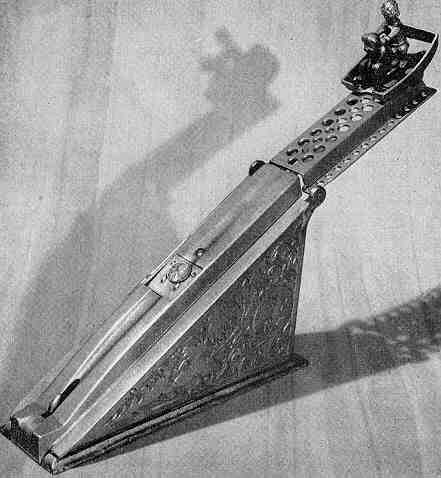Shoot The Chute Bank
by F.H. Griffith - HOBBIES Magazine - January, 1952

The selection of the fourth most desirable mechanical bank poses quite a problem as there are a number of rare and wanted banks that come into the picture after the three obvious leaders, namely Freedman’s, Harlequin, and Merry-Go-Round, which have been covered in previous articles. However, considering the various things that rate a bank among the top in desirability, the Shoot the Chute would seem to qualify for fourth position.
The bank was designed by Mr. Charles Bailey, unquestionably the leader in the field of mechanical bank designing, and manufactured by Stevens in Cromwell, Connecticut. It was patented March 27, 1906 and shown in the Stevens Catalog of that year.
The bank pictured was obtained from V.D. Howe who in turn had purchased it from an antique dealer in Lebanon, Pennsylvania. A point of interest is the fact that the antique dealer found the bank in an old department store where they were disposing of an accumulation of items that had been gathering dust for years in an unused room.
The bank is attractively painted in bright red and gold and has as its theme the ever popular Buster Brown and Tige riding in the car. It operates as follows: First the extension part of the chute is raised as shown in the picture. Normally this is flat against the back of the base. A coin is then placed midway on the chute and the car is released from the top of the extension. As the car slides down the chute it hits the coin and knocks it in the bank, as the coin goes into the bank it hits a lever which raises a hook at the end of the chute. The car hits the hook and Buster Brown and Tige are dumped from the car head over heels.
It is interesting to note that the use of a coin is necessary for the proper action to take place. This bank, of course, could be played with as a toy and to the ordinary person it would not at first appear to be a bank. However, the fact that a coin is necessary to cause proper action is a very desirable feature from a collector’s viewpoint.
There are eight of these banks known to be in private collections, not, however, all with original cars and bases. The bank shown is original throughout and in mint condition.
